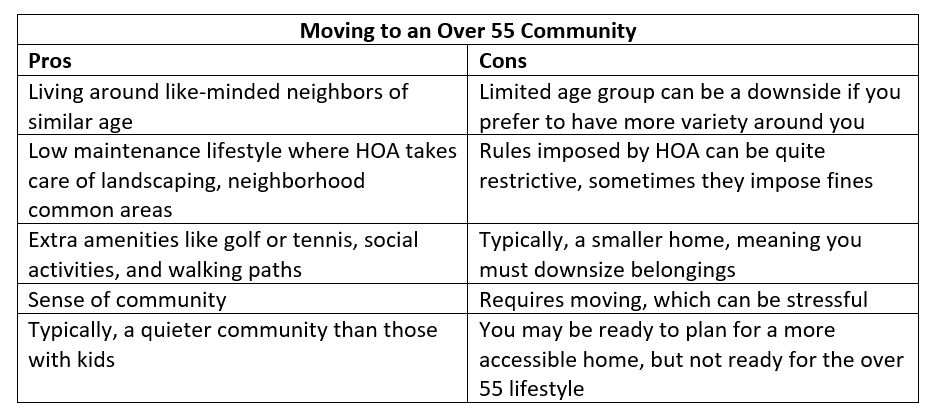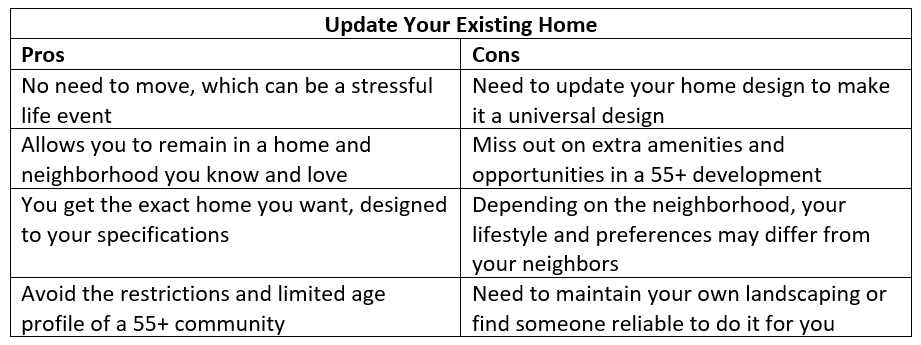Remodeling vs. Investing in an Over 55 Community: Should I Stay or Should I Go?
/The kids have all left for college, or maybe they’ve even graduated and moved on to their own careers and homes. You may not be ready to retire, but as the focus of your life changes it’s important to start planning for the years to come. For over 55s, in addition to assessing the status of retirement funds and planning your first child-free vacation in years, it is also important to think about your home living situation.
If your house is suddenly screaming out for a full home remodel now that the kids are gone, you may ask yourself if a remodel is the right move for this stage of life? Or is it time to think about moving to a purpose-built over 55 community? While 55+ housing developments have benefits, there are also clear advantages to updating your existing home to make it suitable for aging in place.
Home Priorities for Aging in Place
Before you can decide which path is the right one for you, let’s first explore what you need in a home living situation designed for aging in place.
Accessibility: make sure all key living spaces are easily accessible even if you find yourself with reduced mobility.
Universal design: create your home to be usable to persons of all ages and needs, meaning it will be as suitable to you today at age 55 as it will be in 10-20 years.
Prioritize the first floor: you don’t have to have a ranch style home, but you should have a set up that provides at least a kitchen, full bathroom, bedroom, and living room on your first floor. A second floor could be used as your bedroom now but be converted to a home office or later a live-in carers’ room or a guest room.
Easy entrance: include at least one entrance to your house that is flush to the ground, so you have easy access into and out of your house.
Doors and hallways: make sure doorways are wide enough to allow access if you ever need a walker or wheelchair. Similarly, hallways and movement around your kitchen, bathroom, and other key rooms should allow room to manoeuvre a wheelchair.
Simplify your storage: create storage in key locations like the bathroom or kitchen design that is easy to use. Move dishware and other heavy items to drawers or roll out shelves and include pull down storage accessories for upper kitchen cabinets so you can easily access items when you need them.
Remember the small things: details make all the difference when gearing your home for a universal design. Textured floor materials are safer as they help you avoid slipping. Rocker switches, lever door handles, and cabinet pulls instead of knobs are easier to handle when hand strength is diminished or impacted by arthritis.
Outdoor spaces: take a look at outdoor areas including your yard as well as the surrounding neighborhood and make sure they are easily walkable and accessible.
Today’s universal designs allow you to have a home that lets you age in place safely and comfortably. They are also stylish as the latest design innovations and materials balance style and functionality. From open showers to grab bars that accent your accessories, pull down and easy to access kitchen storage, and easy to navigate layouts, accessible home design solutions perform double duty as universal and stylish designs.
Options for Aging in Place
Once you know it is time to create a home that is suitable for aging in place, what are your options? There are two main approaches you can take:
Move to a purpose built over 55 community that creates homes intended for aging in place.
Or update your existing home to a universal, accessible design that allows you to transition into the next phase of your life in your current neighborhood.
There are pros and cons to both approaches, and which one you select really depends on your own priorities. Here is a brief overview of each option:
Which Choice is Right for You?
When deciding which option is the best choice for you, you must examine your own priorities for the next phase of your life. It also helps to assess your current home and neighborhood. If you love your home, enjoy the area you have lived in for years, and have great neighbors you can’t bear to leave, why move when updating your existing home will fit your needs? On the other hand, if you feel you have aged out of your current neighborhood and are ready for a change, it might be time to move.
Understand the Costs
It may sound easier and perhaps more cost-effective to sell your current home and buy a purpose-built home in a 55+ community, but this is not always the case! Many 55 and over communities are now aging themselves, with some as old as 25 years. This means that, while these homes were built for aging in place, they are outdated in terms of style and functionality and will need to be updated before you can comfortably move in.
Let’s break down what this looks like in our own local area of Bucks County, PA. Homes in these over 55 communities around Yardley, Newtown, Langhorne, and Washington Crossing, PA are selling in a price range of $450,000 and up. This is just your starting point. Most houses 20 years and older need significant improvements from when they were built, meaning these 25-year-old homes are probably crying out for a full home remodel.
At a minimum you are looking at investing in a new kitchen and bathrooms, plus you may need to refinish floors and update the décor throughout the home. Average kitchen remodeling projects range from $75,000 to $150,000 depending on the size and scope of work. Bathroom remodeling projects, on the other hand, range from $50,000 to $85,000 based on the size, type of bathroom, and scope of work planned. This means your remodeling costs to overhaul a 20+ year old home could be in the range of $125,000 to $235,000 just to remodel the kitchen and one main bathroom design. Add this to the cost of buying one of these homes, moving costs, and additional decorating costs to transform the home to your personal style, plus any additional spaces that need updating like other bathrooms, and moving to a 55+ community carries a heavy price tag.
So, if you love your current home and neighborhood, you could choose to invest in aging in place by spending those remodeling dollars in your existing home. This allows you to smoothly transition to the next phase of your life without having to move. Make sure you have a set up in your home that can accommodate a full first floor living space, or that you are able to change or expand your first level floor plan.
At Lang’s Kitchen & Bath, we are currently working with clients who are planning ahead for first floor remodels in their existing homes while creating their dream remodel. This means they anticipate eventually moving the bedroom to the first floor (even if they are still occupying a second-floor bedroom) and are creating an accessible master bath design with a thresholdless shower on the first floor. They may also be creating their dream kitchen design, which balances style with the latest storage and technological innovations in a universal design.
If you are ready to create a home that will take you to the next phase of your life, consider your priorities, the options available to you, and your budget. Use these factors to determine whether it is time to move house or invest in your current home. Remodeling your current home has distinct advantages in terms of minimizing the hassle of moving, allowing you to stay in a home you love, and getting the most from your budget. Talk to our experienced team to learn more about remodeling to age in place.









